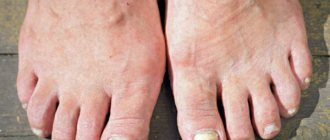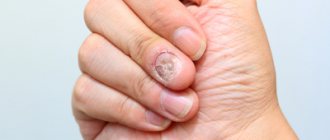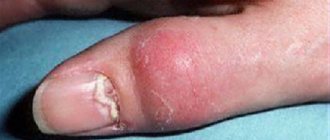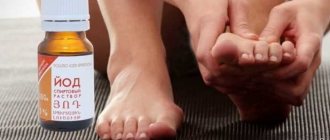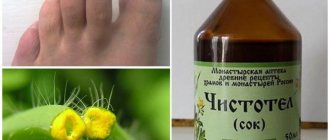Representatives of not only women, but also men are well aware that treating nail fungus with vinegar is an effective option for combating this problem. If we take into account the statistics, the majority of the world's inhabitants suffer from this disease, and are not aware that they can be classified as carriers of onycomycosis. If you do not treat nail fungus with vinegar or other means, all nails will be affected by the disease, as a result of which this situation will lead to negative consequences.
The fungus will disappear in a matter of days. Write down the recipe from Myasnikov...
It is very important to recognize the disease and promptly carry out the correct treatment, which will have an effective result.
Perhaps not everyone knows that vinegar for toenail fungus is considered one of the effective treatment methods, which eliminates the problem in a short time. You can confidently use vinegar against fungus on your toenails and fingernails. But, before using this remedy, you should know exactly how to treat toenail fungus with vinegar, because treating foot fungus with vinegar has its own subtleties.
So, can you cure nail fungus with vinegar? Can you treat nail fungus with apple cider vinegar at home without using additional medications? These common questions often worry people who want to get rid of the disease.
How to recognize the disease
First of all, it is worth understanding that the sooner the problem is detected and treatment is activated, the more effectively and quickly you will get rid of the problem. Those at risk are usually those who often visit places such as saunas, suffer from sweaty feet, and also get pedicures in specialized salons. Treatment of nail fungus, in such cases, is mandatory.
Symptoms:
- Longitudinal scars, as well as round spots, appeared on the nail plate
- The nail has changed color
- The plate peels off and becomes deformed
- The nail has become thick or very thin
- Unpleasant smell
- The finger with the fungus hurts
It is very difficult to recognize the fungus at the initial stage of the disease. But, if the above points are noticeable, we can confidently say that the disease is just beginning to develop. To confirm the disease, a special nail scraping should be taken for analysis, as a result of which laboratory tests will clearly identify the infection.
Recipe No. 3
This recipe is perfect for treating fungal diseases of the nail plate in various forms, including advanced ones.
Compound:
- sea buckthorn, olive or sunflower oil;
- Apple vinegar.
Mode of application:
- Both ingredients are mixed in equal parts and applied using tampons to the affected nail plate.
- The cotton wool soaked in the solution is fixed with a plaster.
- If the fungus has developed on the toenails, then it is advisable to wear socks on top. This compress is done at night.
Effect of vinegar
Everyone knows that vinegar baths are an effective option for counteracting fungus. This solution can be used using a 9% mixture, as well as apple essence. You can use other foot baths, but they may not give a positive result. The fact is that the microorganisms of this disease react very sensitively to an acidic environment, so they stop actively reproducing and subsequently die. Apple cider vinegar against nail fungus is also considered an effective way to combat the disease, but there is a risk that the disease tends to return.
Relapse Prevention
To avoid recurrent disease, you must follow certain rules that minimize the risk of infection:
- Do not use other people's things and objects.
- Observe personal hygiene rules.
- When visiting a bathhouse, sauna and other public places, take personal shoes with you.
- When purchasing shoes and socks, give preference to natural materials.
- Change socks daily.
- Disinfect shoes twice a week.
- Use only personal tools to care for hands and feet.
- As a preventative measure, take vinegar baths once every 7 days.
Vinegar treatment is an economical and effective method in the fight against nail fungus. It is especially effective at the initial stage of development of the disease. Therefore, when the first signs appear, you should immediately begin treatment procedures.
Recommendations
The advanced form is a more complex process that requires additional treatment steps. There is more than one recipe for preparing special mixtures, a recipe for baths, as well as many other treatment options. The recipe is quite simple, so no additional skills are required to prepare the mixture. You can easily find this or that recipe on the Internet.
Rules for preparing a special substance:
- acetic acid is added in the correct consistency, which is the basic rule for effective action. In the first days of use, it is recommended to use mixtures with a low consistency
- Before use, you should steam your feet in well-heated water, carefully remove keratinized areas of skin and delamination
- Vinegar should be used to treat not only sore spots, but also the entire foot and clothes that have been in contact with the fungus
- If there are cracks in the foot, it is not recommended to do similar procedures with vinegar, as this will lead to a burning sensation.
Contraindications and side effects
If the recipe is followed exactly, vinegar remedies against fungus are safe. There are only a few restrictions on their use. Do not use formulations with vinegar in the following conditions:
- Pregnancy and lactation period.
- Children's age up to 10 years.
- Non-fungal skin diseases (psoriasis, eczema, dermatitis).
- The occurrence of a rash and inflammation warns of intolerance to the components.
Do not use home remedies for fungus with vinegar if there are wounds, cracks or burns on the skin.
Treatment methods
Before using any treatment option, you need to make sure that there are no allergic reactions to the components used. Compresses are often made using eggs.
A compress is considered the most effective remedy, because after it the nail is restored. The fungal organism cannot withstand the influence of compresses and dies. Also, the foot is put in order.
Compresses
- The simplest and most effective is considered to be a mixture using vinegar and ordinary warm water, with a ratio of 1-8.
- Mix 2 tbsp. l. essences of vinegar, vodka, as well as 3 whites of ordinary eggs, washed until smooth, use if necessary. This product should be stored in the refrigerator.
- A mixture of apple cider vinegar and vegetable oil in a 1-1 ratio.
The use of such compresses does not require any special skill, because you just need to moisten a cotton swab in this solution and apply it to the nail. As soon as you notice that the compress is drying out, you should re-moisten it in the solution. This procedure is carried out for one hour, after which the foot is rinsed with water and a warm sock is put on. If necessary, you can draw as much water as the bath allows and thoroughly rinse all your feet in hot water. Apple cider vinegar for nail fungus is used only for confirmed illness. For the same diagnosis, vinegar essence is used for nail fungi.
Compress using glycerin and vinegar
Components such as vinegar and glycerin in combination have a positive effect on nail restoration. To prepare a compress, the ingredients are mixed in equal proportions and applied to a previously cleaned and steamed nail.
After applying the resulting solution, wrap the affected area with cling film and apply a bandage on top. The compress is worn for 8 hours, and then carefully removed and the nail plate is lubricated with medicinal ointment to consolidate the effect. The procedure can be performed daily.
Compress using apple cider vinegar
As a replacement for regular vinegar, you can use apple essence, which has a more active environment. The procedure involves soaking a cotton pad or swab in vinegar and applying it to the site of infection.
The attached tampon should be secured with cling film and wrapped with a bandage to obtain the effect. This compress can be used for 2–3 months until the nail plate is completely renewed and the affected part of the nail is gradually removed.
Compress based on vinegar and iodine
The recipe is a good replacement for glycerin, and the preparation technology is to mix 1 tbsp. spoons of apple cider vinegar with 2-3 drops of iodine. The resulting solution is applied to the affected nail, which has been previously cleaned and freed as much as possible from fungal growths.
After the solution is applied, the finger is wrapped in polyethylene and a bandage is applied on top. The compress stays for at least 12 hours. The process can be carried out over several weeks until complete recovery occurs.
Ointments and their active effects
Treatment of toenail fungus with a bite allows you to use special ointments, which also have an effective effect. To prepare such an ointment yourself, you should prepare 100 g of Kalanchoe, 10 g of honey, add 1 tsp. vinegar, as well as 30 ml of eucalyptus oil. Mix all these components thoroughly and store for 3 days in the refrigerator. It is recommended to apply the finished product to the affected area of the nail. This treatment of nail fungus with vinegar essence is very effective.
The second recipe involves mixing a chicken egg, butter, and vinegar. The egg should be poured with vinegar and stored for 4 days in a dark place. After this, the film is removed from the egg and butter is added. As a result, you will get a real ointment that is worth covering the nail with. For a better effect, experts recommend putting a bandage on the nail.
The simplest ointment is considered to be a mixture of vinegar and glycerin in a one to one ratio. This composition can be applied every day to the sore spot until the disease disappears.
Recipe No. 1
Compound:
- 0.5 l 9% table vinegar.
Mode of application:
- You need to take vinegar and heat it slightly.
- Pour the heated vinegar into the bath and dip the affected nail in it. It is imperative that the nails are completely immersed in the liquid.
- Leave it on for about 15 minutes, after which it should not be washed off with running water.
You can apply compresses at night. To do this, just soak your socks in wine vinegar and put them on your feet. Such baths have already been tested by many people who leave only positive reviews. The effectiveness of treatment with vinegar is due to the fact that fungal microorganisms die in an acidic environment.
Baths against fungus
Baths are also distinguished by their active and effective resistance to fungal infections.
- Mix 3 liters of hot water with 1 liter of vinegar and a little potassium permanganate. The color of the mixture should not be bright, but pale pink. The procedure lasts 15 minutes and is repeated every evening. After the bath, your feet should be lubricated with tea tree oil.
- Mix vinegar and carrot juice 1-1. Pour the feet with this solution and keep it in it for about 20 minutes. At the end of the procedure, antifungal ointment should be applied.
All baths should be done using 9% vinegar, used until the disease disappears.
Most people who have suffered from this disease for a long time have found that the above treatment options are very effective. The fact is that they do not require additional costs, actions or special skills. In addition, getting rid of the disease occurs at home, which is very convenient.
Also, it should be understood that the use of such funds does not depend on the age category of the person.
You should not be upset about such an infection and think that it is with you forever. Treatment of nail fungus with vinegar is very effective, which you can test from your own experience and enjoy healthy and beautiful feet at any time.
How to treat toenail and fingernail fungus with vinegar: recipes
For treatment to be effective, the skin and nails must be properly prepared. Before any procedures to eliminate fungus, feet should be washed with laundry soap, remove dead skin from the feet and remove a small layer from the nail plate. This will immediately get rid of a large number of spores and allow the active substances to penetrate deeply into the tissue.
All items used in nail care (scissors, files, clippers) require daily sterilization. The fungus can be defeated only by eliminating the possibility of re-infection.
The simplest method of using vinegar for mycoses is a warm bath for infected areas of the body.
Carrying out the procedure:
- Prepare water by heating it above body temperature, but not more than 50°C.
- Add 1/2 cup vinegar (9%) to 1 liter of water. Can be replaced with apple juice in the amount of 2/3 cup.
- Feet or hands should be completely immersed in the product.
- The bath is carried out daily before bed for at least 15 minutes.
For compresses, use a mixture of acid and water in a ratio of 1:8. A cloth or cotton pads soaked in this solution can be applied to damaged nails and left for up to 60 minutes, then rinsed with running water.
The described procedures are quite gentle and effective in early manifestations of fungus. To eliminate the problem in the later stages and enhance the therapeutic effect, vinegar is mixed with other substances. Compositions of several components have a strong effect, accelerate recovery, and prevent the spread of infection.
With iodine
When treating pronounced symptoms (itching, redness), vinegar for fungus is often used together with iodine. Both substances have fungicidal properties, and when in the same mixture, they enhance each other’s effects.
Preparation and use of the product:
- Mix vinegar and pharmaceutical iodine solution in equal parts.
- Apply the resulting mixture to the nail plates 2 times a day.
- Treatment is continued until the fungus is completely destroyed and a healthy nail grows back.
It may take several months for a final cure. After symptoms disappear, prophylaxis is recommended to prevent recurrence of infection. A vinegar foot bath for fungus is suitable, to which a few drops of iodine are added (5-7). If done every evening for 6 months, it will protect against re-infection.
With medical alcohol
Vinegar is quite active in killing fungus in products containing alcohol. The combination of two aggressive components requires softening their effect. This is achieved by including additional ingredients.
Composition of vinegar lotions against fungus with alcohol and egg:
- 3 raw egg whites;
- 30 ml of medical alcohol or 50 ml of vodka;
- 50 ml vinegar 9%.
To prepare the product, beat the whites, continue stirring, add acid, and then alcohol. Cotton pads or fabric pads are soaked in the composition and placed on sore nails and left overnight.
If essence is used, the solution can be rubbed into the affected areas, but after 15-20 minutes the residue should be washed off.
With hydrogen peroxide
Before curing nail fungus with vinegar, the nail plate is not only cut short and cleaned. It is useful to disinfect tissues, soften and loosen their dense structure. Hydrogen peroxide does this job well.
By foaming, the substance separates dead cells, softens dense areas of the skin, which allows acids to penetrate deep into the tissue. The products are used both alternately and in mixtures.
A simple way to use vinegar and hydrogen peroxide to treat fungus:
- Steam and treat fingernails or toenails.
- A cotton pad is moistened with a pharmaceutical peroxide solution and applied to the affected area for 15 minutes.
- After removing the lotion, treat the nail with 9% vinegar.
The use of hydrogen peroxide reduces the likelihood of infection spreading to healthy tissue. This recipe is used every other day at the initial stage of the disease.
With Kalanchoe
Vinegar against fungus can be used in combination with herbs that have an inhibitory effect on pathogenic microorganisms. The homemade medicinal plant Kalanchoe can defeat the fungus when a fresh leaf is applied daily to the infected nail plate.
The procedure is recommended to be carried out after a warm bath with vinegar. Leave the leaves overnight, securing them with a gauze bandage, socks or gloves. Double exposure helps to quickly defeat infection and restore the integrity of the skin and nails.
With egg
One of the effective home recipes for nail fungus is a vinegar solution with an egg.
Preparation:
- a fresh egg is placed in a narrow glass container;
- completely fill with vinegar solution (70%);
- leave in a dark place for about 5 days until the shell dissolves;
- drain the acid separately, and remove the remaining film from the egg;
- beat the mixture, adding 4 tbsp. l. from the used essence.
The resulting mixture is brought to a creamy consistency by adding butter (up to 200 g). This softens the effect of the ointment and makes it easy to apply to the affected areas. Depending on the individual reaction, the product can be left on the skin for up to 6 hours.
Other recipes
Treatment of nail fungus with vinegar is often supplemented with alkaline compounds. Thus, soda (alkaline) and acid baths, which alternate throughout the day, help many people get rid of the onset of the disease.
A recipe containing dimethyl phthalate, a repellent with pronounced antifungal activity, is known for its effectiveness. The pharmaceutical preparation combines well with the solution and enhances the effect of the home remedy. To prepare an ointment with dimethyl phthalate, you should take the following ingredients in equal quantities:
- any vegetable oil;
- a raw egg;
- vinegar;
- liquid dimethyl phthalate or ointment based on it.
After mixing the ingredients, the resulting ointment is sent to the refrigerator to infuse. After 2-3 hours the product can be used. Apply the composition in a thin layer to areas affected by the fungus, cover with a clean cloth or bandage, and leave for up to 8 hours.
Use of vinegar during pregnancy and children
No one is immune from nail fungus; often this pathology first appears during pregnancy due to a severely weakened immune system. Treatment of fungus with apple cider vinegar and soda is not prohibited during pregnancy, but during therapy it is necessary to make some adjustments to folk recipes. Thus, pregnant women are recommended to reduce the amount of vinegar by half in all recipes and dilute it with water. Thus, if a recipe calls for one spoon of vinegar, you need to add half a spoon each of vinegar and water. This will minimize possible negative effects on the body.
Read also: Pedicure for nail fungus: effectiveness and stages of implementation
Vinegar is prohibited for use by women if pregnancy occurs with complications. During lactation, treatment with vinegar is not carried out.
Vinegar can be used to treat fungus in children only in the form of foot baths. Children's nail plates are much softer than those of adults, so applying pure undiluted vinegar can damage them.
Processing things
Acetic acid is used not only for the treatment of mycoses, but also for preventive measures. With its help, you can disinfect the shoes and personal belongings of a sick person and eliminate the possibility of infecting his loved ones.
Add 1 glass of vinegar to 5 liters of water and wipe furniture, floors, plumbing, shoes and other things with the resulting solution. Before washing, bedding, towels, socks and underwear of the patient should be soaked in water with the addition of vinegar (2 cups per 3 liters) for 2-3 hours.
The room where the patient is located should be wet cleaned every day and windows should be opened for ventilation to prevent relapses of the disease and protect all family members.
Symptoms of onychomycosis
The initial stage of fungal infection is characterized by dryness, cracks, and roughness on the skin. There may be red spots at the site of the lesion.
When you walk in shoes all day, chafing marks appear on your toes, you feel discomfort in the area of the nail affected by the fungus, and you feel pain.
Over time, skin growths may appear on the big toes and feet, and the nail plate becomes dull and yellow at the edges.
The main symptom of onychomycosis is an unpleasant odor. Failure to go to the clinic in a timely manner leads to destruction of nails, spread of pathogenic fungus throughout the body, suppuration and infection of the skin around the nail plate, and discomfort when walking.
Types of onychomycosis
Nail fungus comes in many forms, and each type manifests itself differently:
- Subungual . Partially affects the nail plate, forming yellow dots or stripes on its surface. Damage to areas under the nail layer makes the skin wet, flaky, and the nail crumbles and changes in shape.
- Proximal . The deformation occurs closer to the middle of the nail, involving the skin around the fingers. The skin turns red, cracks, and gets wet. This form of fungus is characterized by itching and an unpleasant odor after removing socks and shoes.
- Superficial . This form of mycosis infects the entire nail plate, also affecting the skin between the fingers. It develops only on the legs. The fungus completely destroys the structure of the nail, causing new wounds for the proliferation of fungal spores.
New forms of the fungus may be added to the above-mentioned forms, depending on the degree of the disease and the type of pathogen. For effective therapy, it is first necessary to determine the type of fungus by passing medical tests.
